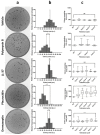Antimicrobial Peptides Can Generate Tolerance by Lag and Interfere with Antimicrobial Therapy
- PMID: 36297604
- PMCID: PMC9611985
- DOI: 10.3390/pharmaceutics14102169
Antimicrobial Peptides Can Generate Tolerance by Lag and Interfere with Antimicrobial Therapy
Abstract
Antimicrobial peptides (AMPs) are widely distributed molecules secreted mostly by cells of the innate immune system to prevent bacterial proliferation at the site of infection. As with classic antibiotics, continued treatment with AMPs can create resistance in bacteria. However, whether AMPs can generate tolerance as an intermediate stage towards resistance is not known. Here, we show that the treatment of Escherichia coli with different AMPs induces tolerance by lag, particularly for those peptides that have internal targets. This tolerance can be detected as different morphological and physiological changes, which depend on the type of peptide molecule the bacterium has been exposed to. In addition, we show that AMP tolerance can also affect antibiotic treatment. The genomic sequencing of AMP-tolerant strains shows that different mutations alter membrane composition, DNA replication, and translation. Some of these mutations have also been observed in antibiotic-resistant strains, suggesting that AMP tolerance could be a relevant step in the development of antibiotic resistance. Monitoring AMP tolerance is relevant vis-á-vis the eventual therapeutic use of AMPs and because cross-tolerance might favor the emergence of resistance against conventional antibiotic treatments.
Keywords: antimicrobial peptide LL-37; antimicrobial peptides; dermaseptin; pleurocidin; polymyxin B; tolerance.
Conflict of interest statement
The authors declare no conflict of interest.
Figures




References
Grants and funding
LinkOut - more resources
Full Text Sources
Research Materials

